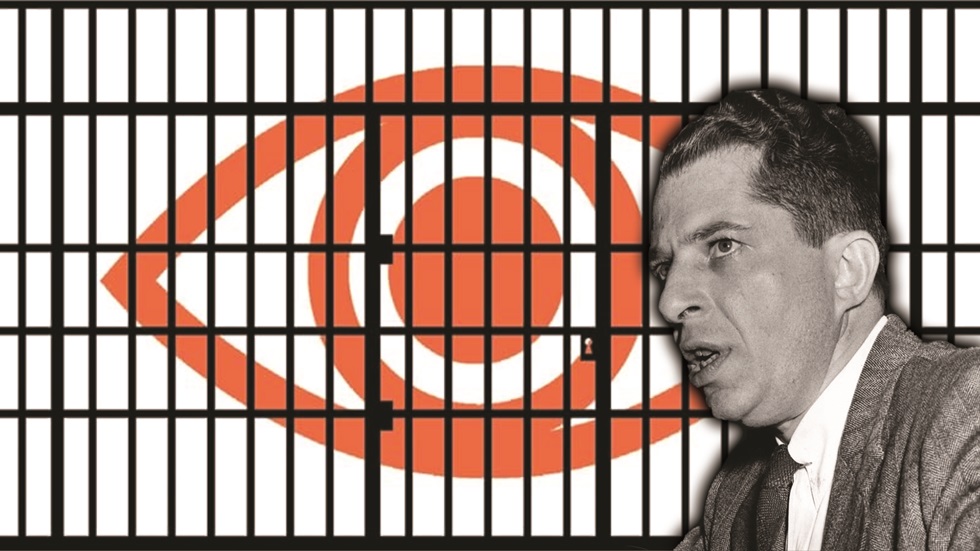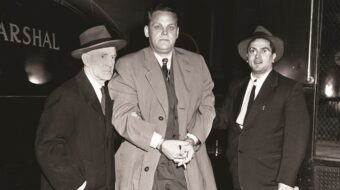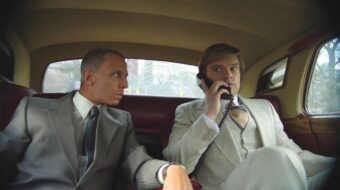
A Long Day in a Short Life, just released in a beautiful new paperback edition by Alma Books, is available for the first time since 1957.
You’ve probably never heard of it. Set in the Washington, D.C., jail, and written by a Jewish American leftist ex-convict, with input from an African-American leftist ex-convict, the book was boycotted by Cold War-era commercial publishers.
Had it been embraced rather than suppressed, it might have become a canonical work, perhaps a staple in U.S. schools.
A prison novel
Albert Maltz’s desire to write a prison novel did not begin with his incarceration in 1950 for refusing to answer the question, “Are you now or have you ever been a member of the Communist Party?” in testimony before a congressional committee. His interest in crime and punishment was formed much earlier. In 1926, his uncle was convicted on a charge of armed robbery and sent to the Ossining Correctional Facility in New York. For several months, young Albert, 18, paid him regular visits. Out of these visits came questions about the origins of criminal behavior and its effects on the individual.

The uncle’s case was not a miscarriage of justice—he was guilty. He had not stolen bread in hunger but had participated in the theft of a truckload of expensive furs. Nevertheless, the root cause was poverty. As Maltz understood, the 40-year-old man was driven by a hunger for more of the world’s wealth than society gave him for his labor. Recalling the prison visits decades later, Maltz found it significant that the Saturday morning train to Sing Sing was crowded with the poor of New York City, almost exclusively the poor.
Maltz’s own imprisonment was the second experience that led him to write A Long Day in a Short Life. In an atmosphere of anti-communist hysteria, he was one of ten screenwriters and motion picture figures who were blacklisted, declared guilty of the crime of Contempt of Congress, and sentenced to a year in jail.
The case became known as that of the Hollywood Ten. In 1947, Maltz and his colleagues were summoned to Washington for interrogation by the House Committee on Un-American Activities (HUAC), chaired by J. Parnell Thomas. Maltz refused to answer its red-baiting questions and instead gave a statement:
“The American people are going to have to choose between the Bill of Rights and the Thomas committee. They cannot have both. One or the other must be abolished in the immediate future.”
This did not go over well. Maltz was committed to the federal jail in Washington in June 1950. Although he would serve the main part of his sentence at Mill Point Prison in West Virginia, he remained in the D.C. lockup for 18 days. It was there that A Long Day in a Short Life was conceived.
By Maltz’s own admission, his acclimation to prison life was harrowing. He had not known the meaning of freedom until it was taken away. In a claustral cell, each day seemed endless.
After a week he managed to acquire pencils and paper. Over the next 10 days he made 70 pages of notes for a novel. Then he learned that he could not take the papers with him or send them to the outside. The night before he was transferred to West Virginia, he memorized the notes, tore them up and flushed them down the toilet.
Conditions were better at the rural Mill Point Prison. As soon as he could get his hands on paper and pencil, he rewrote his observations.
Upon his release from Mill Point in April 1951, Maltz went to work. By the end of the year, he’d finished a first draft. “I had expected it to pour out of me,” he recalled, “and so it seemed to come.”
A Long Day in A Short Life centers on Huey Wilson, an 18-year-old from a poor but striving Black family. Wilson works by day, takes classes at night, drives himself hard and dreams of becoming a prominent civil rights attorney. He is first seen on a picket line leading a demonstration against Jim Crow segregation in the Washington, D.C., school system in 1946.
After the protest, Wilson is stalked and savagely attacked by four white men. He is rescued in the nick of time by a middle-aged passerby, Tom McPeak, a Georgia-born white man who doesn’t know Wilson but jumps into the fight and saves the younger man’s life.
Immediately the police frame Wilson for the crime of being Black, working up fake charges of felony assault, while the would-be lynchers get a slap on the wrist. McPeak is arrested too, but he is offered a deal: he can go free if he will leave town without testifying, thereby allowing the police to clinch the frame-up that will saddle Wilson with a 20-year sentence.
The rest of the narrative takes place in the course of one day in the Washington jail. It revolves around the question of what McPeak will do with his personal ethical dilemma. Initially the white man turns away from Wilson because his plight seems hopeless, a race-based injustice that is “as old as the United States itself, and wouldn’t be solved in a day.”
But as Wilson and McPeak converse, they find common ground. McPeak is a spot-welder in a Ford plant in Detroit. From his experience organizing factory workers and leading labor actions, he has learned the adhesive power of common interest and shed his racist upbringing. He realizes that deserting Wilson would be exactly like scabbing on his fellow workers in a strike. To him, interracial unity is not an abstract term but the only real tool for achieving justice.
McPeak remembers something taught to him by a Black worker during a sit-down strike in the 1930s. When a laborer wants to better himself, there are two keys to open the door. One of them is white and the other black. Wilson understands and finishes the thought. “We’re the two keys in this situation, aren’t we, Tom? If we work together, we can open this jail door.” For both men, the metaphor of the keys is “a bottom truth.”
A serious flaw and a major rewrite
In early 1952, Maltz shared the draft manuscript of the novel with his friend A.B. Magil, a communist writer and editor of the journal Masses & Mainstream who had followed Maltz’s career from its beginnings. Both men were now living in Mexico as political refugees. Magil took in the manuscript eagerly and responded, “The book has impressed and moved me deeply as a work of great truth and superlative artistry.”
While Magil found the novel compelling and courageous, he also felt it contained “ideological errors” in its treatment of race. Among them, the fact that “Huey’s awakening comes not from his own people, but from the preachments of a white man” was a serious flaw. “White progressives inevitably move among pitfalls in this area,” Magil counseled, “and often we are only partly conscious of them.”
A week later Maltz responded to this criticism in a lengthy letter, reminding Magil that the Black liberation struggle would necessarily involve unification with white progressives, and that “it is among Marxists that Negroes will find their staunchest allies.”
But the matter was far from settled. Magil had sent the manuscript to other Masses & Mainstream editors, including Lloyd Brown, an African-American writer and labor organizer. Brown had recently published his own well-received prison novel, Iron City, based on his experiences in the segregated cellblock of the Allegheny County Jail near Pittsburgh.
Brown read Maltz’s manuscript, along with his 13-page response to Magil, and was offended by both. He saw the character Huey as an “artistic failure” and was outraged by the book’s “utter and illimitable ignorance of the essence of Negro life.” The problem was not just that Maltz had written a white savior story, but that his work displayed a lack of consciousness of the historical burdens of Blackness.
In the novel, Maltz had allowed a white progressive to proclaim that American Blacks “must and will fight.” Brown found it necessary to remind the Jewish American author that millions of African Americans had been fighting “every hour and every minute for over 300 years” in an “unremitting struggle for freedom and equality.” He had also detected in Maltz’s writing a condescending set of assumptions about methods of racial liberation as expressed by a “literate progressive” whose treatment of Black culture was not based on lived experience.
“The Negro is a soldier who never gets a furlough,” Brown wrote on June 1, 1953, adding,
“Good God, man, don’t tell him that he ‘must and will fight’!… And don’t come up here to Harlem hollering ‘Fight’! Don’t talk like that to Lloyd. L. Brown, who first heard that word from an aged Negro woman who had walked a thousand miles barefoot in the snow to Freedom.”
The scorching indictment closed with a suggestion: “Go ahead, Albert Maltz—write about any kind of typical Negro, good, bad, or middling. But first, be wise enough and humble enough to find out something about the Negro people.”
The Black novelist’s rhetoric was potent. Maltz’s groping, soul-searching response was, in human terms, also impressive:
“Dear Lloyd Brown,
“Reading and re-reading your letter has been a painful experience…. I will destroy this novel of mine and I never will publish another line before I consciously will do harm to the Negro Liberation Movement, or to the cause of unity between the white working class and the Negro people…. The fact that I may be without malice, does not excuse ignorance…. After twenty years in the progressive movement I have certain responsibilities. One of these responsibilities is that of knowing something about the struggles of the Negro people…. I don’t mean that you have the obligation of trying to mend my ignorance. I am seeking criticism.
“I am fighting for a piece of work in whose truth and value I believe.”
For the next five weeks, Maltz licked his wounds, reflecting on Brown’s assessment. Then on July 14 he wrote again to Brown, informing him of the outcome of his self-examination:
“I think all of your criticisms are sound. My point of view on the book has changed. I believe I thoroughly understand the distortions it contains.
“I hope my persisting confidence that I can handle this material with truth is not mistaken. In any instance, I now am preparing for a major re-write, from page 1 on.

“I know I have listened; I hope I have learned; we will see the results.”
The results were brilliant. The new version of A Long Day in a Short Life retained the story of McPeak and Huey Wilson, changed in ways that cultural work rarely accomplished in previously realized American fiction.
The completion of A Long Day in a Short Life demanded from Maltz both introspection and substantial growth—as a novelist and human being. Yet he persisted, internalizing Brown’s criticisms while keeping faith in his art.
Finally, the blacklist
These efforts did not make U.S. publishers any more receptive to Maltz’s work—or willing to break the blacklist. In 1953, Maltz’s long-time publisher, Little, Brown and Company, rejected the novel.
Over the next three years A Long Day in a Short Life received 18 rejections from American publishers while getting 16 contracts for publication in foreign countries. Running out of U.S. options, Maltz gave the novel to International Publishers—a press whose communist affiliations ensured that the book would not be widely read or reviewed—so that at least his friends could read it.
Published in June 1957, A Long Day in a Short Life sold less than 1000 copies. Only a few leftist journals recognized its power. In the Afro-American, Saunders Redding called it “both tough and tender. Its toughness derives from its truth; its tenderness derives from its deep compassion.” In People’s World, Mike Gold stated, “It is a masterly piece of work that will deepen your knowledge of America.” In Mainstream, Philip Stevenson observed, “Albert Maltz’s first novel in eight years is not only the best of his work; it is one of today’s most important novels. It seems almost incredible that eighteen American publishers refused it.”
A book for our time
Sixty-six years later, those rejections remind us that there’s a price to pay for proto-fascism.
And while the new edition repairs a loss to literary history, it could also fill a gap in our educational system. As a literature teacher, I’m already anticipating the deep discussions this text will support. I have a hunch it will resonate, not only with students. Why? Those letters between Maltz and Brown are important. Cross-racial collaboration against the U.S. “injustice” system is not simply an idea in this book; it’s what inspired and shaped the novel in the first place.
A Long Day in a Short Life can be purchased here.
We hope you appreciated this article. At People’s World, we believe news and information should be free and accessible to all, but we need your help. Our journalism is free of corporate influence and paywalls because we are totally reader-supported. Only you, our readers and supporters, make this possible. If you enjoy reading People’s World and the stories we bring you, please support our work by donating or becoming a monthly sustainer today. Thank you!












Comments